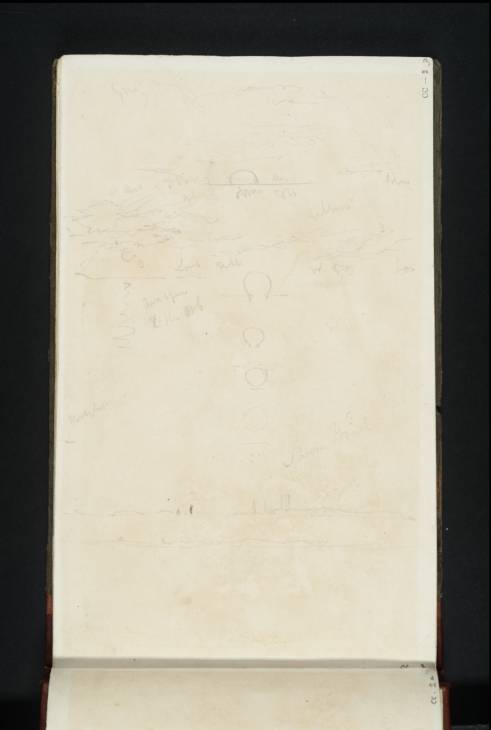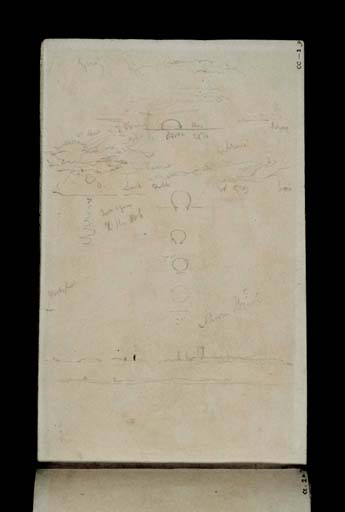Joseph Mallord William Turner Memoranda of Sunrise; And a sketch of Spurn Point 1822
Image 1 of 2
Joseph Mallord William Turner,
Memoranda of Sunrise; And a sketch of Spurn Point
1822
Joseph Mallord William Turner 1775–1851
Folio 3 Recto:
Memoranda of Sunrise; And a sketch of Spurn Point 1822
D17512
Turner Bequest CC 3
Turner Bequest CC 3
Pencil on white wove paper, 187 x 114 mm
Inscribed in pencil by Turner ‘grey’ top left, ‘Red’, ‘Gale’, ‘Purple’, ‘Red’, ‘Gold’, ‘Yellow’, ‘Blue’ around the top sketch; ‘L[...]’, ‘Purple’ ‘W grey’ around the second sketch down; ‘[?]Reflection | of the orb’ upper centre left; ‘H[...]’ lower centre left; and ‘Spurn Point’ centre right
Inscribed in pencil by ?Ruskin ‘3’ top right running vertically
Inscribed in pencil by ?Finberg ‘CC.3’ bottom right
Stamped in black ‘CC 3’ top right running vertically
Inscribed in pencil by Turner ‘grey’ top left, ‘Red’, ‘Gale’, ‘Purple’, ‘Red’, ‘Gold’, ‘Yellow’, ‘Blue’ around the top sketch; ‘L[...]’, ‘Purple’ ‘W grey’ around the second sketch down; ‘[?]Reflection | of the orb’ upper centre left; ‘H[...]’ lower centre left; and ‘Spurn Point’ centre right
Inscribed in pencil by ?Ruskin ‘3’ top right running vertically
Inscribed in pencil by ?Finberg ‘CC.3’ bottom right
Stamped in black ‘CC 3’ top right running vertically
Accepted by the nation as part of the Turner Bequest 1856
Exhibition history
1857
Marlborough House, London, and other venues, 1857–8 (235 [NG no.438c]).
References
1900
John Ruskin, Modern Painters Vol.V. second edition, London 1900, pp.186 reproduced as block cut fig.97, 187.
1904
E.T. Cook and Alexander Wedderburn (eds.), Library Edition: The Works of John Ruskin: Volume XIII: Turner: The Harbours of England; Catalogues and Notes, London 1904, pp.300, 301 reproduced as block cut fig.6, 302.
1909
A.J. Finberg, A Complete Inventory of the Drawings of the Turner Bequest, London 1909, vol.I, p.610, CC 3, as ‘Memoranda of sunrise. Exhibited Drawings, No. 438c, N.G.; engraved in “Modern Painters”, vol.5 (pt.viii, chap.4, sec.7). Also an outline of “Spurn Point.”’.
1961
Alexander J. Finberg, The Life of J.M.W. Turner, R.A. Second Edition, Revised, with a Supplement, by Hilda F. Finberg, revised ed., Oxford 1961, pp.277–8.
1975
Gerald Wilkinson, Turner’s Colour Sketches 1820–34, London 1975, p.23 reproduction of ‘a wood engraving of a copy by Ruskin [...] in Modern Painters V’.
1981
Gerald Finley, Turner and George the Fourth in Edinburgh 1822, exhibition catalogue, Tate Gallery, London 1981, pp.81, [93] reproduced as ‘Memoranda of sunrise. Exhibited Drawings, no. 438c, N.G.; engraved in John Ruskin, “Modern Painters”, (vol.5 pt.viii, chap.4, sec.7). Also an outline of “Spurn Point”’.
1982
Turner Society News, no.24, Summer 1982, p.8.
Although the sketches of sunrise on this and the opposite page (folio 2 verso; D17511) are not related to any particular project or picture they are nevertheless important to Turner as a painter of nature and particularly of light, and have had an even greater significance to Turner studies. John Ruskin singled out the sketch, illustrating it in the fifth volume of Modern Painters and describing it as ‘probably one of the most important sketches made in Turner’s life, fixing for ever in his mind certain facts respecting the sunrise from a clear sea-horizon’.1 The illustration is also used in Ruskin’s Catalogue of the Sketches and Drawings by J.M.W. Turner, R.A., Exhibited in Marlborough House, 1857–1958; and folios 2 verso and 3 were on display in that exhibition and subsequent touring exhibitions for several decades (see folio 2 verso).2 Ruskin’s analysis, as Gerald Wilkinson has noted, helped to establish ‘an early precedent for the study of Turner through his sketches’.3
The ‘Memoranda of Sunrise’ as Ruskin put it, begins on folio 2 verso with a sketch of a multicoloured sky and yellow sun seen between horizontal layers of clouds. As the sun is well above the horizon, this must either be the end of the sunrise sequence, or even a sketch of the sunset the previous evening. A sketch of the Norfolk coast above includes the inscription ‘Red sun on water’. This suggests that Turner was sketching Norfolk towards evening, and took the opportunity to draw the sun setting. That night the boat he was travelling in sailed or steamed on towards the south-east Yorkshire coast. Turner rose early the next morning to record the appearance of the sun rising, making a sketch of Spurn Point as it came into view. The first appearance of the sun above the horizon is recorded at the bottom of folio 2 verso.
Ruskin begins describing the sequence of sketches from the top of folio 3:
(Half circle at the top.) When the sun was only half out of the sea, the horizon was sharply traced across its disk, and red streaks of vapour crossed the lower part of it.
Above, the sky is cloudy and ‘Grey’ and the sea is ‘Blue’ and ‘Gold’ where the sun is reflected in the water:
(Horseshoe underneath.) When the sun had risen so far as to show three-quarters of its diameter, its light became so great as to conceal the sea-horizon, consuming it away in descending rays.
The clouds above now appear less heavy and have been lit up ‘purple’ at the left and ‘yellow’ at the right, although the lower portion is still ‘W[hite]’and ‘Grey’. At the left of this sketch is the final sketch of the sequence with the sun, now fully risen, reflected in the water. Turner’s wavy vertical line is a shorthand technique that he frequently used for sunrises and sunsets.
The third sketch down is described by Ruskin as:
(Smaller horseshoe below.) When the point of detaching itself from the horizon, the sea, and looked as if pulled down by it.
Below this is a:
(Broken oval.) Having risen about a fourth of its diameter above the horizon, the sea-line reappeared; but the risen orb was flattened by refraction into an oval.
The final sketch shows a:
(Broken circle.) Having risen a little farther above the sea-line, the sun, at last, got itself round, and all right, with sparkling reflection on the waves just below the sea-line.
At the bottom of the page are two slight sketches of ‘spurn point’, the uppermost shows a row of buildings: the old lighthouse and lifeboat station built in 1810. Below is another sketch of the narrow spit of Spurn Point.
This is the most elaborate of seven folios in this sketchbook containing studies of the sun and sky at sea (folios 1, 2 verso, 61 verso, 78, 85 verso, 88 and 91; D17508, D17511, D17614, D17644, D17664, D17670). The sea journeys to and from Edinburgh afforded Turner the opportunity to watch sunsets and sunrises over the sea (folios 88 and 91), to experiment with compositions dominated by clouds (folios 1, 61 verso, 78 and 91), to study various weather and light effects (folio 78, 85 verso, 91) and to record shipping subjects with dramatic skies. Turner held a sustained interest in studying skies throughout much of his career (see D13394; Turner Bequest CLXV 41a), and there is a sketchbook from around 1816–18 dedicated to Skies (Tate D12449–D12527; D40582; Turner Bequest CLVIII complete group). In fact two of the studies in the present sketchbook may not belong to this Scottish tour at all, but were perhaps made prior to it (folios 1 and 85 verso).
Technical notes:
This drawing so impressed Ruskin that he included it, along with several others from the sketchbook, in the selection of drawings by Turner on rotating display at Marlborough House. That it was extensively exhibited is evinced by the yellowed paper, with a narrow border remaining white where it was covered by a frame or mount. The number ‘3’ in the top right corner of the page is therefore probably Ruskin’s, made before he removed the page to be exhibited. Finberg then inscribed his own number based on that at the bottom left of the page before the book was rebound and stamped with its Turner Bequest number.
This drawing so impressed Ruskin that he included it, along with several others from the sketchbook, in the selection of drawings by Turner on rotating display at Marlborough House. That it was extensively exhibited is evinced by the yellowed paper, with a narrow border remaining white where it was covered by a frame or mount. The number ‘3’ in the top right corner of the page is therefore probably Ruskin’s, made before he removed the page to be exhibited. Finberg then inscribed his own number based on that at the bottom left of the page before the book was rebound and stamped with its Turner Bequest number.
Thomas Ardill
July 2008
How to cite
Thomas Ardill, ‘Memoranda of Sunrise; And a sketch of Spurn Point 1822 by Joseph Mallord William Turner’, catalogue entry, July 2008, in David Blayney Brown (ed.), J.M.W. Turner: Sketchbooks, Drawings and Watercolours, Tate Research Publication, December 2012, https://www


